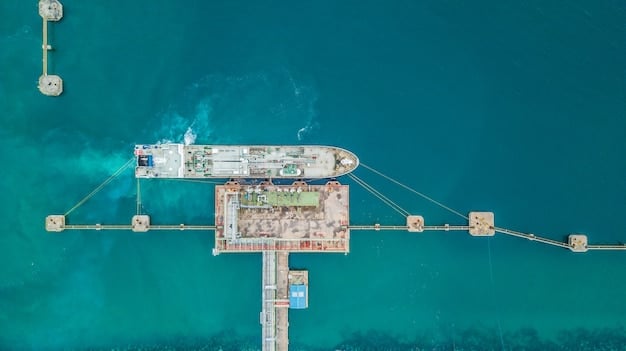US Ocean Sustainability: Financial Incentives for Businesses Explained


Dive into the world of US Ocean Sustainability, where ocean health meets economic opportunity. In today’s era, US businesses are discovering that protecting marine ecosystems isn’t just ethically sound, it’s financially savvy.
Explore how aligning strategy with sustainable ocean practices can drive innovation, attract investment, and secure long-term resilience.
The Shifting Tides of Profit: How US Ocean Sustainability Became a Smart Business Strategy
The advancement of US Ocean Sustainability has redefined the relationship between environmental responsibility and business growth.
What was once viewed as a compliance burden has become a powerful driver of profitability, innovation and resilience.
Today, aligning with sustainable marine practices is not only encouraged by national policy, it is incentivized by investors and demanded by the public.
With the United States formally committing to sustainably manage all marine areas under its jurisdiction, businesses are entering a new economic landscape.
Through this strategy, companies are gaining access to fiscal benefits, regulatory advantages and long-term market relevance, all rooted in a sustainable ocean economy.
Stronger regulations drive smarter decisions
Agencies like NOAA and the State Department are implementing regulations that reward innovation and forward-thinking strategies.
Instead of imposing penalties, the current approach promotes collaboration and investment in technologies that reduce marine pollution, protect habitats and improve resilience.
Companies that take initiative benefit from smoother permitting processes, eligibility for public grants and early adaptation to regulatory shifts. These advantages position them ahead of competitors and reduce future legal and environmental risks.
Consumers are rewarding responsible companies
Public consciousness around ocean degradation is influencing market behavior. Customers are now actively seeking out businesses that follow the principles of US Ocean Sustainability.
This includes support for ethical fishing, elimination of single-use plastics and engagement in local conservation efforts.
These preferences create strong brand loyalty and increase willingness to pay for sustainable alternatives. Businesses that demonstrate transparency and environmental commitment attract attention, build trust and grow a more resilient customer base.
Investors recognize sustainability as long-term value
Environmental, Social and Governance (ESG) metrics are becoming central to investment decisions. Companies that embrace US Ocean Sustainability are viewed as less risky, more future-oriented and better prepared for market transitions.
This growing investor preference translates into access to lower-cost capital, stronger stock performance and inclusion in sustainable investment portfolios.
Financial institutions increasingly seek partnerships with ocean-positive enterprises that align with long-term value creation.
Healthy oceans sustain profitable industries
Ocean-dependent industries such as shipping, fisheries and coastal tourism are directly impacted by the health of marine ecosystems. A decline in biodiversity or water quality can lead to loss of productivity, operational disruptions and rising insurance costs.
By supporting US Ocean Sustainability, businesses contribute to the protection of vital resources and ensure the long-term viability of the environments they depend on.
Clean, stable ecosystems result in fewer interruptions, better yields and a more predictable business climate.
Sustainability leads to measurable efficiencies
Adopting sustainable practices often results in reduced waste, optimized energy usage and increased operational efficiency. For example, fuel-efficient vessels not only lower emissions but significantly cut costs.
Similarly, implementing better water management systems in processing facilities reduces both resource usage and utility expenses.
These improvements go beyond environmental gains. They strengthen a company’s financial structure, enhance scalability and make operations more adaptable to future challenges.
Unlocking Public Support: Government Grants and Funding for US Ocean Sustainability
For businesses aligning with US Ocean Sustainability, there is significant public support available in the form of grants, subsidies, and financial programs.
These resources are designed to empower companies that prioritize ocean conservation and sustainable practices, helping them innovate and grow while contributing to the protection of marine ecosystems.
Federal and state agencies across the U.S. have intensified their commitment to sustainable ocean management, reinforcing the idea that ecological preservation and economic advancement can—and must, go hand in hand.
Understanding these funding opportunities is essential for any business looking to become a leader in US Ocean Sustainability.
Federal agencies prioritize ocean conservation and innovation
The National Oceanic and Atmospheric Administration (NOAA) is at the forefront of federal support for US Ocean Sustainability.
Through competitive grants, NOAA funds initiatives such as coastal habitat restoration, marine debris removal, sustainable fisheries development and ocean climate resilience.
These projects are often designed to enhance biodiversity, improve water quality and create scalable solutions for marine health.
The Environmental Protection Agency (EPA) also plays a vital role. It provides funding for pollution control, wastewater treatment and environmental remediation in coastal zones.
These initiatives directly contribute to the success of US Ocean Sustainability, especially for businesses working in port operations, aquaculture or offshore infrastructure.
Cross-agency programs expand sustainability funding
Other federal departments such as the Department of Energy and Department of Commerce contribute to US Ocean Sustainability through clean energy and infrastructure programs.
Offshore wind development, for example, is often funded with an emphasis on minimizing marine impact and supporting biodiversity. These projects highlight the intersection of renewable energy and sustainable ocean use.
Additionally, funding aimed at climate adaptation, like reinforcing coastal structures or restoring natural marine buffers, enables businesses to stay resilient while advancing US Ocean Sustainability goals.
State-level support reinforces local sustainability efforts
State governments are key partners in implementing US Ocean Sustainability at a regional level.
Coastal states such as California, Florida and Massachusetts have created their own marine-focused grant programs that support projects like sustainable aquaculture, plastic reduction, shoreline protection and pollution control.
These localized programs often have quicker review timelines and are better suited for businesses that operate in specific ecosystems.
For any company engaged in ocean-related industries, tapping into state-level support can provide a crucial boost in their sustainability transition.
Effective proposals turn vision into funding
Securing grants for US Ocean Sustainability efforts requires clear, well-structured proposals. Most public funding programs demand documentation that outlines environmental impact, cost-effectiveness and alignment with strategic marine goals.
Companies that build strong partnerships with research institutions or conservation groups tend to stand out in competitive funding rounds.
A successful proposal shows not only environmental value but also how the project contributes to the broader mission of advancing US Ocean Sustainability in measurable and lasting ways.
Reducing Tax Burden Through US Ocean Sustainability: Credits and Deductions Explained
Businesses committed to US Ocean Sustainability can unlock significant tax advantages that directly support their environmental goals.
Tax credits and deductions are powerful financial tools that reduce the cost of implementing sustainable marine practices. These incentives make eco-conscious investments not only environmentally responsible but also economically strategic.
By understanding and utilizing the available programs, companies can offset initial capital expenditures while reinforcing long-term profitability through compliance and innovation.
Federal programs support clean ocean operations
The U.S. federal government offers a range of tax credits aimed at promoting environmental innovation and energy efficiency.
While not always exclusive to the marine sector, these incentives are often adaptable to businesses involved in US Ocean Sustainability.
The Investment Tax Credit (ITC) is a leading example. It allows businesses to recover a portion of the cost associated with installing renewable energy systems such as solar panels or offshore wind infrastructure.
These systems can be integrated into port operations, processing facilities or even fishing vessels that utilize clean energy on board.
There are also deductions for businesses investing in fuel-efficient engines, hybrid propulsion systems and shore power (cold ironing) technology at ports.
These upgrades not only reduce harmful emissions but also qualify for accelerated depreciation, enabling companies to recover their investment faster while reducing their taxable income.
State and local incentives expand the benefits
In addition to federal programs, many states offer tax credits that directly support US Ocean Sustainability practices.
Coastal states in particular provide localized incentives for companies that invest in green infrastructure, pollution control systems and sustainable packaging for marine-related products.
For example, a business in California might receive a tax exemption for installing an advanced water treatment system at a coastal facility.
In Massachusetts, companies transitioning to eco-friendly aquaculture operations may be eligible for deductions tied to equipment upgrades that improve environmental performance.
These regional programs are often more targeted and responsive to local ecological needs, giving marine businesses additional ways to reduce costs while aligning with sustainability goals.
Certification can unlock further fiscal advantages
Certain tax credits are linked to environmental certifications. Businesses that achieve designations such as ISO 14001 for environmental management or sustainable seafood certifications may become eligible for additional financial relief.
These certifications reinforce a company’s commitment to US Ocean Sustainability, improving both regulatory positioning and public perception.
In some cases, they also serve as prerequisites for accessing broader incentive programs or participating in government-funded projects.
Documentation is essential for maximizing returns
To take full advantage of available tax benefits, businesses must maintain accurate records of qualifying expenses and sustainability investments.
Tracking upgrades, equipment costs and installation timelines ensures eligibility and compliance with evolving tax codes.
Working with professionals who specialize in environmental taxation can help businesses navigate the complexities of these programs.
Expert guidance reduces the risk of missed opportunities and maximizes the financial return on sustainability efforts.
Sustainability becomes a financial strategy
By integrating tax credits and deductions into their broader planning, businesses committed to US Ocean Sustainability can reduce the net cost of innovation and accelerate their environmental transitions.
These incentives do more than support eco-friendly practices. They strengthen financial performance, increase operational efficiency and reinforce a company’s long-term value in the evolving marine economy.
Tax advantages transform sustainability into a smart, strategic decision that benefits both the planet and the bottom line.
Financing the Future: Access to Preferential Lending and Investment through US Ocean Sustainability

The rising relevance of US Ocean Sustainability has shifted the mindset of the global financial sector. Today, sustainability is not seen as a cost center but as a powerful indicator of long-term financial health and market stability.
Businesses committed to preserving marine ecosystems are now rewarded with preferential financing options, greater investment opportunities and stronger investor confidence.
Banks, investment funds and development institutions increasingly view sustainable marine enterprises as resilient, low-risk and aligned with future policy and consumer trends.
This has created an environment where financial capital actively flows toward businesses contributing to a healthier ocean economy.
Green loans offer better terms for sustainable ocean practices
Financial institutions across the United States are offering tailored green loans to support projects that demonstrate clear environmental benefits.
These loans come with favorable conditions, such as lower interest rates, extended repayment terms and reduced collateral requirements.
Companies advancing US Ocean Sustainability can use these loans to upgrade vessels with fuel-efficient engines, develop sustainable aquaculture systems or build eco-tourism infrastructure with minimal environmental impact.
These improvements reduce operating risks while reinforcing a business’s long-term adaptability to climate and regulatory changes.
ESG-focused investors expand access to capital
Impact investors and ESG-oriented funds are actively seeking businesses that align with US Ocean Sustainability. These investors look beyond short-term returns and focus on companies that deliver both profit and measurable environmental value.
For marine businesses, this unlocks access to a growing pool of patient capital. Whether through private placements or equity partnerships, ESG-aligned funding enables scalable growth while preserving the mission of ecological responsibility.
Companies with strong sustainability narratives are increasingly viewed as ideal candidates for long-term partnerships.
Public programs de-risk sustainability financing
Public sector support also plays a key role in financing US Ocean Sustainability.
At both federal and state levels, development banks and green finance initiatives provide loan guarantees and low-interest funding to stimulate sustainable infrastructure development.
Although a national Green Bank is still in development, several states have established their own mechanisms to fund renewable energy, coastal protection and clean technology implementation.
These initiatives reduce the financial risk for private lenders and enable marine enterprises to secure capital with greater confidence.
ESG performance influences equity investment and valuation
Strong ESG performance directly impacts how a company is perceived by institutional investors.
Firms that demonstrate environmental responsibility, transparent reporting and commitment to US Ocean Sustainability often receive higher valuation multiples and broader access to stock market investment.
In the marine sector, this might include seafood companies with certified sustainable sourcing, port operators with clean energy strategies or maritime logistics businesses reducing carbon emissions.
Sustainability is now a marker of operational discipline and reputational strength, both of which drive investment.
Clear communication attracts sustainable capital
To benefit from preferential lending and investment, businesses must clearly articulate how their operations support US Ocean Sustainability.
This includes publishing ESG metrics, aligning with global frameworks such as GRI or SASB, and obtaining credible environmental certifications.
Investors and lenders rely on data to evaluate impact. Companies that report on marine conservation efforts, emissions reduction or water quality improvements are better positioned to secure funding in a competitive market.
A well-defined sustainability vision not only supports funding applications but also reinforces trust with all stakeholders.
Sustainable finance drives long-term advantage
Access to capital is one of the most powerful enablers of growth. By aligning with US Ocean Sustainability, companies unlock new sources of funding, reduce the cost of capital and attract partners who prioritize resilience and innovation.
This creates a compounding effect, where each sustainability milestone strengthens financial performance and future readiness.
In today’s economy, sustainability is no longer a peripheral concern. It is a core component of investment strategy, and businesses that lead in protecting marine ecosystems are now leading in finance as well.
Building Consumer Loyalty Through US Ocean Sustainability: Brand Trust and Market Advantage
In today’s value-driven marketplace, a company’s alignment with US Ocean Sustainability has become a core component of public image and brand strength.
Businesses that commit to protecting marine ecosystems are not only seen as responsible but are also rewarded with deeper consumer trust, greater loyalty and long-term brand equity.
For marine-oriented industries, sustainability is no longer a marketing angle. It is a foundational expectation that shapes how the public perceives, engages with and supports a brand.
Consumers choose brands that reflect environmental values
Modern consumers increasingly base their purchasing decisions on a brand’s commitment to environmental protection.
When a business actively supports US Ocean Sustainability, it builds credibility with customers who are looking for ethical and transparent options.
Implementing practices such as reducing plastic waste, supporting sustainable seafood sourcing or offering low-impact tourism creates an authentic narrative.
This narrative appeals to a growing demographic that prioritizes responsibility over convenience and quality over quantity.
A sustainable reputation justifies premium positioning
In competitive markets, businesses associated with US Ocean Sustainability can distinguish themselves as leaders.
This reputation allows them to position their products and services as premium, creating room for stronger pricing and better margins.
For example, seafood brands with certified sustainable practices or packaging companies using ocean-safe materials are often favored by retailers and consumers alike.
These choices reflect quality and values, which translate directly into sales performance and brand preference.
Environmental credibility protects against reputational risks
In the digital age, brands are constantly under public scrutiny. Missteps can escalate quickly, but companies that have a consistent record of sustainability tend to recover more easily from criticism.
Supporting US Ocean Sustainability establishes a base of goodwill that acts as a reputational safety net. Customers, partners and the general public are more likely to stand by businesses that have shown long-term commitment to doing the right thing.
Sustainability strengthens employer branding
A company’s environmental reputation also influences who wants to work there. Many professionals, especially younger generations, seek careers aligned with their personal values.
Companies that embrace US Ocean Sustainability often attract more engaged and motivated employees.
This alignment leads to higher retention rates, better performance and a stronger internal culture. Employees who believe in their company’s mission often become passionate advocates, further amplifying the brand’s reach and influence.
Positive reputation improves external partnerships
A well-regarded sustainability track record also opens doors to collaborations with other ethical brands, smoother relations with regulatory bodies and improved community engagement.
Businesses seen as champions of US Ocean Sustainability often find themselves welcomed into exclusive markets, preferred by eco-conscious partners and invited to participate in public initiatives.
These relationships enhance operational efficiency and increase the potential for strategic growth.
Brand equity becomes a long-term competitive asset
Every initiative that supports US Ocean Sustainability contributes to a brand’s intangible value. This reputation builds over time and translates into stronger customer loyalty, media visibility and access to premium market segments.
When sustainability is genuinely embedded in business strategy, it becomes a self-reinforcing cycle. Doing good for the ocean builds trust, and that trust fuels business success in a way that is both measurable and enduring.
Risk Mitigation and Long-Term Viability
Adopting sustainable marine practices is not just about capitalizing on new opportunities; it’s also a fundamental strategy for mitigating risks and ensuring the long-term viability of businesses dependent on healthy ocean ecosystems.
Environmental risks, regulatory shifts, and climate change impacts pose significant threats, and proactive sustainability measures can buffer against these challenges, protecting assets and securing future operations.
One of the most immediate risks mitigated by sustainable practices is regulatory non-compliance. Environmental regulations in the U.S. governing marine and coastal activities are complex and ever-evolving.
Non-compliance can result in substantial fines, legal battles, operational shutdowns, and severe reputational damage.
By proactively implementing sustainable practices that often exceed baseline regulatory requirements, businesses reduce their exposure to these penalties and position themselves ahead of future, potentially stricter, environmental laws.
This foresight creates a more predictable operating environment.
Climate change presents a multifaceted risk to marine businesses. Rising sea levels threaten coastal infrastructure, ocean acidification impacts shellfish industries, and extreme weather events disrupt shipping and fishing operations.
Investments in climate resilience, such as elevating structures, protecting coastal wetlands, or diversifying aquaculture species, are direct sustainable practices that reduce physical risks.
While these require initial investment, they prevent far greater potential losses from climate-induced disruptions, ensuring operational continuity and protecting valuable assets like ports, processing plants, and fishing fleets.
Operational risks can also be significantly reduced. For instance, in fisheries, overfishing leads to stock collapse, threatening the livelihoods of entire communities and the viability of fishing businesses.
Adopting sustainable fishing quotas and methods ensures the long-term health of fish populations, guaranteeing a renewable resource for future harvests.
Similarly, in aquaculture, sustainable practices that minimize disease outbreaks and reduce reliance on wild-caught feed improve the resilience and profitability of farming operations, avoiding costly losses and supply chain vulnerabilities.
Furthermore, supply chain resilience is bolstered through sustainable practices. Businesses that rely on marine resources or transportation can face disruptions due to environmental degradation or resource scarcity.
By sourcing sustainably or engaging in practices that enhance the health of marine ecosystems, companies secure their access to vital inputs.
This forward-looking approach ensures a stable and reliable supply chain, protecting against price volatility and availability issues that can arise from ecosystem decline.
Insurance costs also reflect risk.
Businesses with demonstrable sustainable practices and a reduced environmental footprint may qualify for lower insurance premiums, as they are perceived as less likely to incur large environmental liabilities or suffer from climate-related damages.
This direct financial incentive underlines how sustainability translates into tangible savings on overheads.
Ultimately, neglecting sustainability is a significant risk in itself, potentially leading to stranded assets, diminished brand value, and exclusion from capital markets.
By adopting sustainable marine practices, U.S. businesses protect the environment while strengthening operations, reducing risks and securing long-term success. Sustainability is now essential to any resilient business strategy.
Driving Operational Excellence Through US Ocean Sustainability: Supply Chain Efficiency and Innovation
Implementing US Ocean Sustainability practices often leads to far more than environmental benefits. It opens the door to supply chain optimization, cost reduction and long-term resilience.
As companies reevaluate their operations through a sustainability lens, they discover ways to streamline processes, reduce waste and boost profitability without compromising environmental goals.
Sustainable marine practices transform supply chains from reactive systems into strategic assets, helping businesses lead in efficiency and innovation.
Reducing waste creates savings and new revenue streams
Minimizing waste is one of the most immediate gains when aligning with US Ocean Sustainability. For marine businesses, this includes redesigning packaging to use less plastic, adopting improved sorting systems at ports and reusing organic byproducts.
Fish processing facilities, for example, can turn leftover parts into fertilizers or animal feed. This reduces disposal costs and creates new product lines. Waste no longer represents a loss, but a resource.
Energy efficiency boosts margins and reduces emissions
Investing in cleaner energy technologies significantly improves the bottom line. Fuel-efficient ships, optimized routing and the adoption of solar or wind energy onboard or at facilities can drastically reduce fuel expenses.
Port operations benefit from electrifying vehicle fleets, modernizing cranes and using smart lighting systems. These upgrades lower energy consumption and improve overall performance while supporting US Ocean Sustainability targets.
Smart water management cuts costs and improves compliance
Aquaculture and processing plants often use large amounts of water. Implementing closed-loop systems, modern filtration and water recycling technologies reduces both consumption and discharge.
Besides lowering utility bills, these improvements help avoid pollution fines and align the business with responsible marine resource use. Sustainable water practices become both a cost-saving tool and a compliance asset.
Smarter logistics increase speed and sustainability
Transport and logistics can also be enhanced through US Ocean Sustainability efforts. Better cargo organization, shipment consolidation and multimodal transport options reduce emissions and delivery times.
Digital tools like real-time tracking and predictive analytics add another layer of efficiency. The result is a leaner, greener logistics chain that reduces overhead and supports faster, cleaner distribution.
Circular economy design strengthens resource security
The circular economy is central to long-term sustainability. Marine businesses that design products for durability, repairability and recyclability contribute to ocean health and resource efficiency.
For instance, creating fishing nets that are easy to repair and reuse minimizes plastic waste and reduces raw material demand. This shift from disposable to regenerative design supports both environmental goals and long-term operational stability.
Sustainability drives continuous innovation
Embracing US Ocean Sustainability transforms supply chains into innovation hubs. Companies are pushed to rethink outdated processes, adopt emerging technologies and collaborate more effectively.
The result is a stronger, more resilient operation that is prepared for resource constraints, regulatory shifts and consumer expectations. Optimizing the supply chain through sustainability is no longer a niche idea, it is a blueprint for future-ready business.
Adapting to Climate Change and Coastal Resilience

Climate change continues to reshape coastlines and marine ecosystems, posing urgent challenges to U.S. businesses operating near the ocean. Rising sea levels, more intense storms and shifting weather patterns are no longer distant threats.
They are active forces disrupting operations, damaging infrastructure and endangering long-term viability.
Integrating climate adaptation and coastal resilience into business strategy is now a key pillar of US Ocean Sustainability.
These actions not only safeguard physical assets but also enhance financial security, improve investor perception and unlock government support.
Rising sea levels demand proactive infrastructure upgrades
Many marine businesses are located in vulnerable coastal zones. Ports, seafood processing plants, aquaculture sites and tourism facilities face increasing risk of erosion, flooding and structural damage.
Investing in elevation, relocation or reinforcement of critical infrastructure is essential. This includes protective barriers, elevated buildings and nature-based solutions that serve as buffers.
While these projects may require substantial capital, the cost of inaction often includes business disruption, asset loss and reduced competitiveness.
Public programs support climate-resilient operations
Government agencies are expanding funding for coastal resilience. FEMA provides grants for hazard mitigation, including shoreline stabilization and infrastructure adaptation.
NOAA offers resilience programs that support local business partnerships through climate planning and risk reduction projects.
At the state level, coastal management offices also fund initiatives that align with US Ocean Sustainability, such as ecosystem restoration, stormwater control and resilient construction.
Accessing these funds helps businesses reduce financial burden while preparing for future climate events.
Insurance incentives reward climate adaptation
Insurance providers increasingly consider climate preparedness in their premium calculations. Businesses that adopt resilience measures often qualify for lower rates due to reduced exposure to loss.
This financial incentive reinforces the value of US Ocean Sustainability investments. Actions such as restoring wetlands, upgrading drainage systems or reinforcing structures not only reduce risk but also generate measurable savings over time.
Nature-based solutions combine ecology and protection
Restoring natural defenses like salt marshes, oyster reefs and mangroves delivers ecological and financial value. These systems reduce storm surge, control erosion and improve water quality while supporting biodiversity.
Marine businesses that invest in or collaborate with restoration projects contribute to ecosystem health and benefit from reduced physical vulnerability.
These green infrastructure solutions are often more cost-effective and adaptable than traditional concrete barriers.
Climate-ready businesses attract capital and trust
Companies that incorporate climate risk into their long-term planning demonstrate foresight and leadership. Aligning operations with US Ocean Sustainability sends a strong message to investors, regulators and local communities.
This commitment improves creditworthiness, strengthens market reputation and positions the business as a preferred partner. Investors increasingly seek climate-resilient companies that can weather environmental uncertainty and deliver consistent value.
Operational continuity is critical in a changing climate
When extreme weather hits, businesses with adaptive infrastructure recover faster. Resilience planning protects supply chains, sustains production and minimizes customer disruption.
In the context of US Ocean Sustainability, building climate-ready systems is not only an environmental choice. It is a strategic investment in long-term stability, market confidence and economic survival.
| Key Incentive | Brief Description |
|---|---|
| 💰 Grants & Funding | Government agencies (NOAA, EPA) offer non-repayable funds for eco-friendly marine projects. |
| 📈 Tax Credits & Deductions | Investments in sustainable tech or practices lead to reduced tax liabilities. |
| 💸 Preferential Lending | Access to “green loans” with better terms from financial institutions focused on ESG. |
| 🛡️ Risk Mitigation | Reduces exposure to regulatory fines, climate impacts, and enhances supply chain resilience. |
Frequently Asked Questions About Sustainable Marine Practices
▼
The primary financial benefits include access to government grants and tax credits, preferential lending terms, enhanced brand reputation and increased consumer loyalty, operational efficiencies leading to cost savings, and significant risk mitigation against regulatory penalties and environmental disruptions. These combine to improve the bottom line.
▼
Government agencies like NOAA and EPA provide grants for various sustainable marine projects, including coastal restoration, sustainable fisheries, and pollution prevention. These funds help businesses finance research, development, and implementation of eco-friendly technologies and practices, reducing the financial burden and encouraging innovation in the marine sector.
▼
Yes, businesses can leverage various federal and state tax credits and deductions for investments in eco-friendly technologies and practices. These include credits for renewable energy installations, energy efficient upgrades, or accelerated depreciation for cleaner equipment. Such incentives directly lower taxable income, making sustainable investments more financially attractive.
▼
Businesses with strong sustainability credentials often gain access to preferential lending and investment. Financial institutions offer “green loans” with favorable terms, and impact investors prioritize companies with strong ESG (Environmental, Social, and Governance) performance. This broader access to capital reflects lower perceived risk and aligns with growing investor demand for responsible investments.
▼
Adopting sustainable practices helps mitigate significant financial risks. Businesses reduce exposure to regulatory fines, avoid costly litigation from environmental damage, and become more resilient to climate change impacts like sea-level rise and extreme weather. This proactive approach ensures long-term operational continuity and protects valuable assets, leading to reduced insurance costs and enhanced stability.





